Reaping the Rewards: ‘Return to Dark Tower’
Posted by admin on

This modern sequel to the 1981 electronic board game Dark Tower calls for new heroes to take on the challenge.
In “Reaping the Rewards,” I take a look at the finished product from a crowdfunding campaign. Return to Dark Tower was initially funded on Kickstarter in February of 2020, and was delivered to backers earlier this year. Since the game was limited to Kickstarter backers and was not put into retail, Restoration Games ran a second campaign on Backerkit this fall, with an expected delivery date next summer. You won’t find it in stores (unless they got it through one of the campaigns), but there’s still a day left for a late pledge to the Backerkit campaign.
What Is Return to Dark Tower?
Return to Dark Tower is an app-driven cooperative game for 1 to 4 players, ages 10 and up, and takes about 2 hours to play. The initial print run of the game was for Kickstarter backers only, but a second Backerkit campaign this year funded a second print run and you can still make a late pledge for that until October 31, with a pledge level of $150 for the base game, or $299 for the whole collection (base game, both expansions, and some other bonuses). Otherwise, it will be available in stores that pledged to the campaign once it arrives mid-year 2023.
There’s a lot going on in the game, but because it is fully cooperative and a lot of things are handled by the app, I think the 10-and-up is a reasonable recommendation. I did play with my youngest daughter at age 8 and the biggest difficulty was simply that it’s a long game and so it can be hard on smaller attention spans. Some of the foes have scary appearances (though it’s static artwork, not animated) and the tower plays sound effects, so that’s also a factor if your kids would be creeped out by that.
Return to Dark Tower was published by Restoration Games. The design team was Tim Burrell-Saward, Isaac Childres, Noah Cohen, Rob Daviau, Justin D. Jacobson, and Brian Neff. The artists were JJ Ariosa, James Bousema, Tim Burrell-Saward, Lindsay Daviau, Hakan Diniz, Chad Hoverter, Garrett Kaida, Qistina Khalidah, Jason D. Kingsley, Punga Miniatures, and Jason Taylor.

Return to Dark Tower Components
Here’s what comes in the box:
- Game board
- 4 Hero boards
- Electronic Tower (with 12 seals)
- Haggle die
- 26 Skulls
- 4 Hero figures
- 16 buildings (4 each Citadels, Sanctuaries, Villages, and Bazaars)
- 3 Quest markers
- 22 Treasure cards
- 20 Foe cards
- 10 Companion cards
- 16 Virtue tiles
- 12 Corruption cards
- 18 Gear cards
- 18 Potion cards
- 20 Quest Item cards
- 16 Heroic Test cards
- 65 Foe tokens
- 40 Spirit tokens (1- and 5-value)
- 50 Warrior tokens (1- and 5-value)
- 6 Dungeon tokens
- 20 Special tokens (8 Spore, 8 Siege Trees, 4 River of Fire)

The star of the show, of course, is the tower itself, so let’s take a closer look at it. It stands about a foot tall, and the exterior has some dark red plastic that generally appears black, but glows red when parts of it light up. (In some of my photos, it looks lighter red because of the flash.) There are twelve “seals” around the four sides of the tower—small plastic panels that slide up and off. The interior of the tower has three rotating sections behind the seals, which allows for either an opening or a panel with a glyph behind each door. At the top is a small well with a hole, where you drop plastic skulls—they can come out of one of the four openings at the base, or be directed to one of the openings in the rotating sections, to fall out of a higher opening or be trapped behind a closed seal. I will note that because of the shape of the hole and how light the skulls are, if you drop them from too high they tend to bounce back out.
Matt is telling Carson: “Don’t drop the skull from that high! It’s going to bounce back out!” Photo: Jonathan H. LiuThe tower runs on three AAA batteries, and uses Bluetooth to connect to a mobile device, which is required to play. The app syncs with the tower and manages some of the gameplay, particularly random events. The tower has a speaker and plays various sound effects during the game—for instance, when a foe is spawned, it will play that foe’s sound effect. (The app has its own sound that plays on your device, for things like background music.) One thing that can be a little tricky is that the tower is big enough that it blocks a section of the board behind it, so you may find yourself needing to stand up or lean around to see what’s happening on that side of the board.
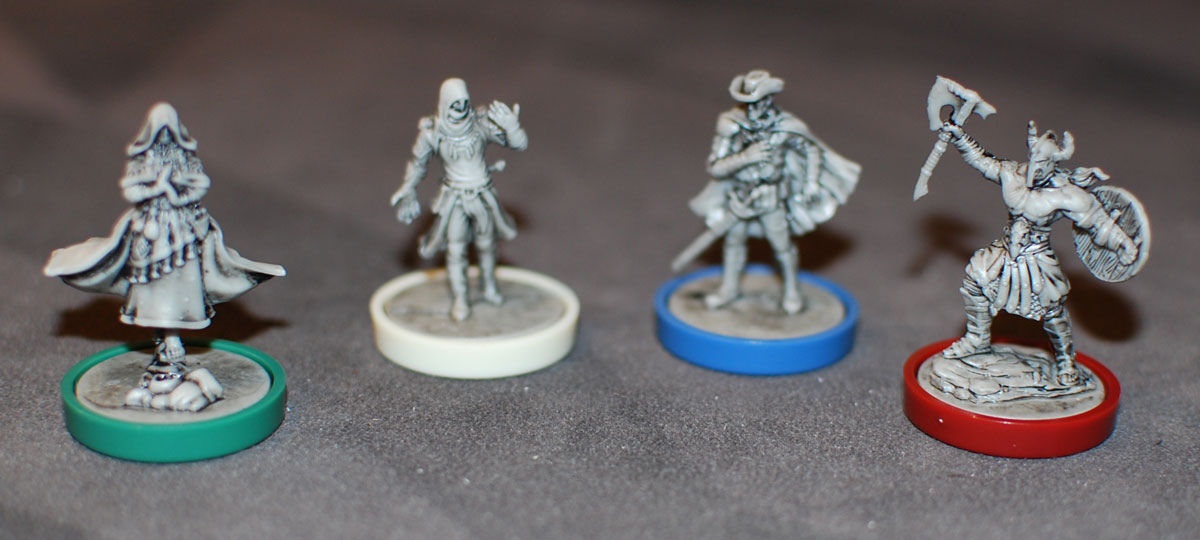
The four hero miniatures come with an ink wash that adds some shadows and helps accentuate the details. There are also colored bases that snap onto the bottom, which is also nice for being able to identify the characters if you don’t paint them.
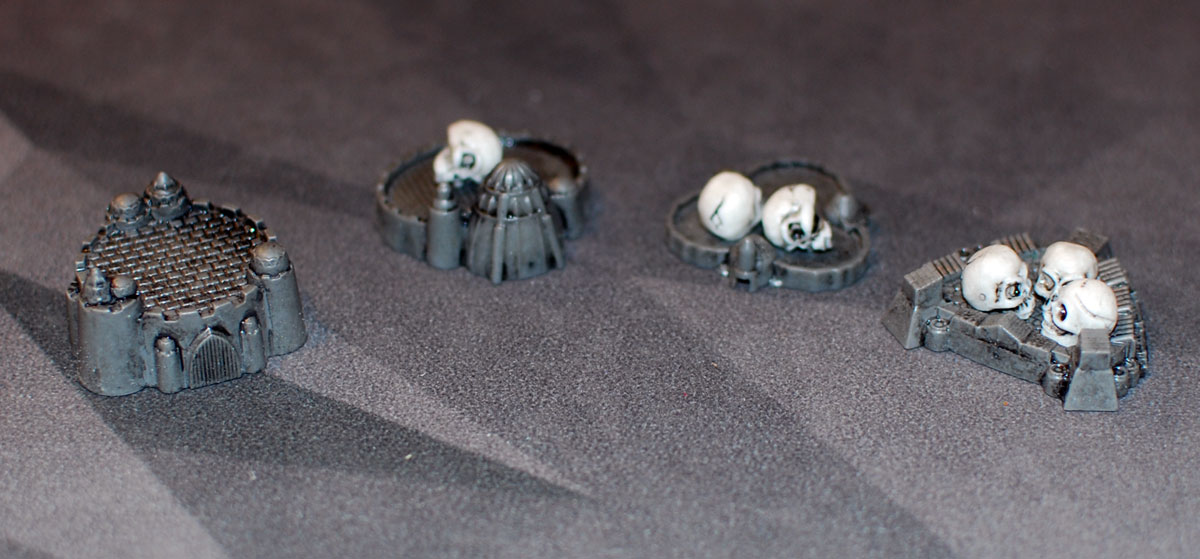
There are four building types, and these also come with the ink wash. Each one has a flat surface where you will place the small plastic skulls, which are also nicely detailed. The game uses 24 skulls and includes two extras in case you misplace some.

The game comes with cardboard tokens to represent the various foes you’ll battle—each one is marked with its level (from 2 to 5) as well as some traits. In each game, you’ll use one foe of each level. The “Dark Horde” add-on gives you miniatures of all the foes to replace the cardboard tokens, but I don’t have that myself and found the tokens to be just fine.

The foe cards, treasure cards, and companion cards are all full-sized cards, and the rest are half-sized cards.
The foe cards show the level and traits on one side, and on the other side they show the types of effects that the foe has when you battle it, along with the effect of that foe’s events when they trigger. You don’t strictly need these to play the game, but they can be used to randomize the set of foes for the game, and as a reference for those who want to know the potential consequences before they go into battle.

The haggle die is a six-sided die, made of white pearlescent plastic, with engraved and inked symbols on the various sides. Although it only has two “no haggle” faces, they seem to appear more than a third of the time—or maybe that’s just for me.
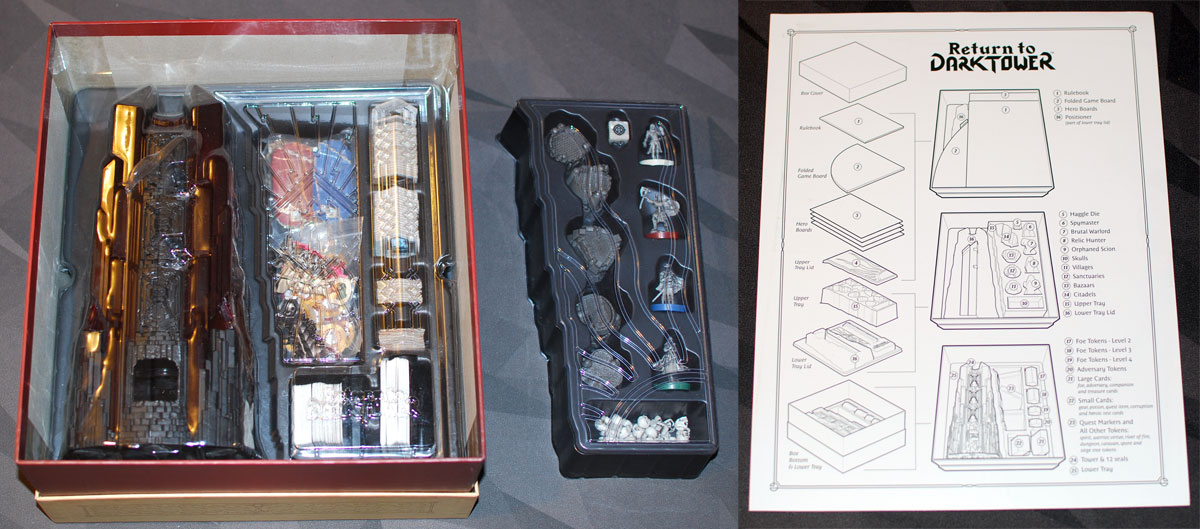
The whole thing packs away nicely into the custom storage trays, which are designed to have room for sleeved cards. There’s also a sheet that includes the packing instructions—in my opinion, every game that has a lot of components should come with something like this to help you keep things organized. Don’t forget to take the batteries out before you put it all away if you’re not going to be playing it for a while!
How to Play Return to Dark Tower
You can download a copy of the rulebook here.
The Goal
The goal of the game is complete the main quest, and then defeat the adversary within six months, and before triggering a loss condition.

Setup
Set out the board with the tower on it, and the fire up the app. It will connect to the tower and calibrate it, and then you get to pick your game settings: cooperative or competitive, “Heroic” or “Gritty” difficulty, and whether you’re using any expansions. You will choose a main goal (tied to one of the companions), an adversary, and then your three foes.
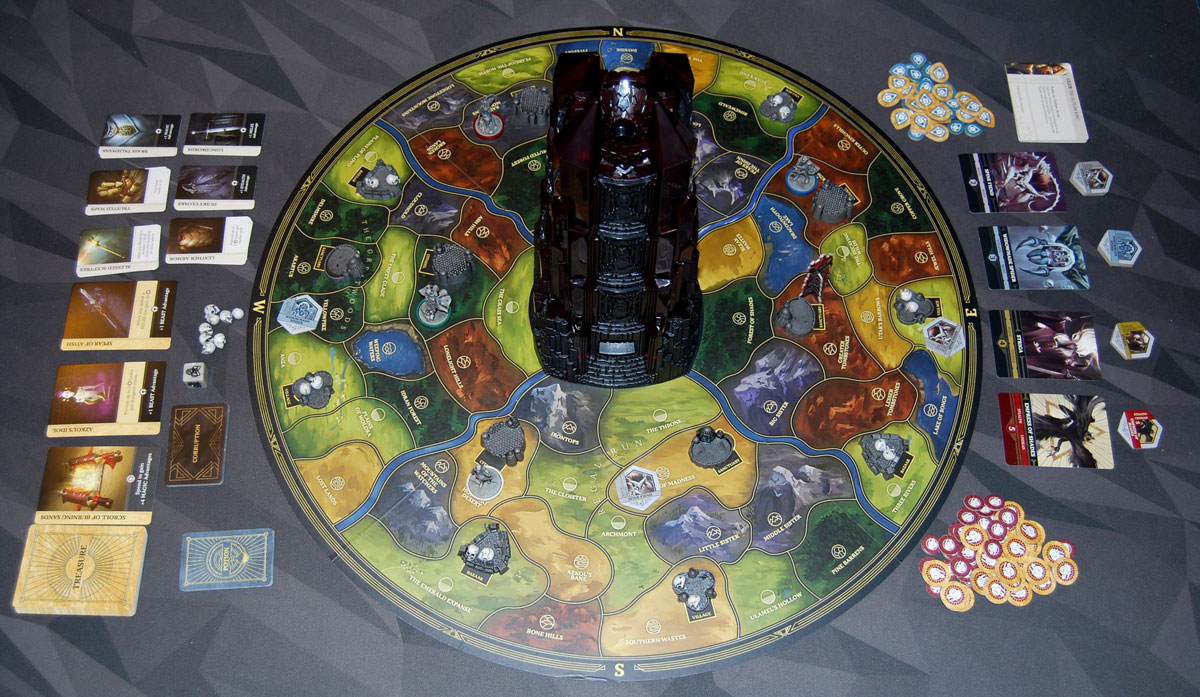
The board is divided into four kingdoms: each one has one of each building (regardless of player count). You set out the six different types of gear (using one card less than the number of players for each stack), as well as the treasure cards with three cards turned face-up. The potion cards, corruption cards, and companion cards are also set nearby in case you need them. Retrieve the tokens for the foes you’ll be using and set them next to the board. You’ll also have a supply of skulls, spirit, and warriors. The app will instruct you on where to place skulls, enemies, and the main quest marker, as well as any additional setup that may be needed.
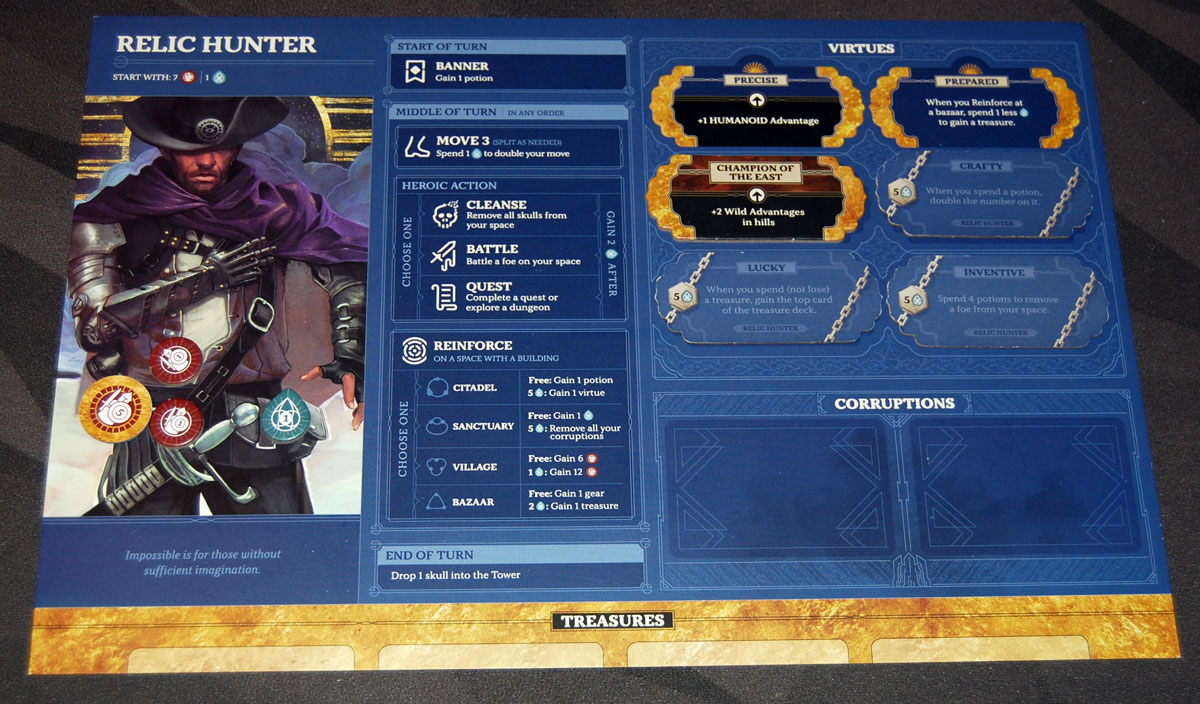
Each player takes a hero sheet and takes 7 warriors and 1 spirit. You take the three virtue tiles for your character and place them face-down. You also take the kingdom virtue tile (based on which kingdom you’re seated near). Your hero figure starts on the space with the citadel in your home kingdom. At the beginning of the game, you have two character-specific virtues (printed on your board), and the kingdom virtue. The others must be unlocked before you can use them.
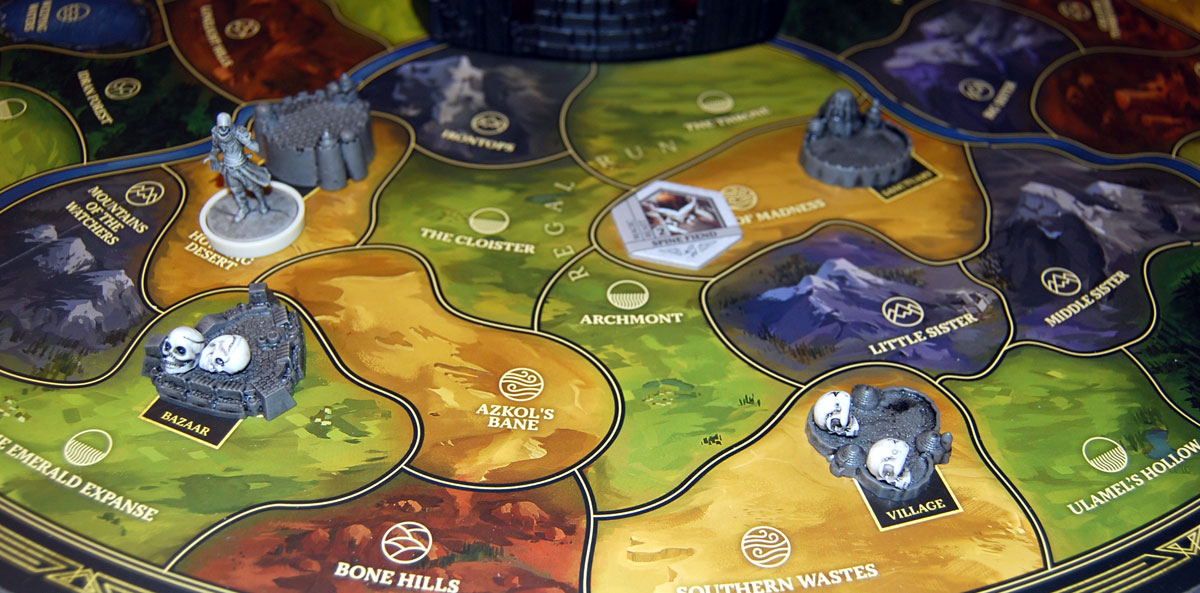
Gameplay
On your turn, you follow the turn guide in the middle of your hero sheet: use your banner, then three different actions, and then drop a skull in the tower.
First, you use your banner effect—this is different from each character but typically gives you a little bonus.
Then, you may do three things in any order: move, a heroic action, and reinforce.
You may move from region to region, including crossing rivers, and typically nothing stops you from moving—you can be in the same space as enemies or other players. If you spend 1 spirit, you may double your movement. Your movement may be split up, taking some other actions and then resuming movement afterward.
You have a choice of three heroic actions: cleanse, battle, and quest.
To cleanse, remove all the skulls from the building in your current space and put them back into the supply.
If you’re in the same space as an enemy, you may battle it. Tap the battle icon on the app and select the foe you are fighting. It will bring up a screen with several “cards”—you must tap cards equal to the enemy’s level. Then, the app will reveal one card at a time and you suffer the effects.

During the battle, you may use up to 10 advantages. You can gain advantages for battling in a particular terrain type (your kingdom virtue gives you a specific terrain bonus), and you can also gain advantages against particular traits—for instance, the Brutal Warlord hero has an innate virtue that gives him +1 Melee advantage. Treasures, potion, and gear can all give you advantages.
For each advantage you spend, you can “improve” a card to mitigate its effect. The card can only be improved so many times, indicated by the little spots around the arrow icon. At the start of the game, the three foes are “ready” and their cards begin with 3 dots. You can spend up to 2 advantages to bring them down to 1 dot. As the game progresses, the foes will advance from “ready” to “savage” to “lethal, which means their cards will start with harsher effects and it will cost more advantages to bring them back down. Some cards (like this card from the Spine Fiend seen above) can be improved to have no losses, and others may even give you a benefit if they’re improved enough. There are also cards that are critical hits, and will have negative effects even if fully improved.
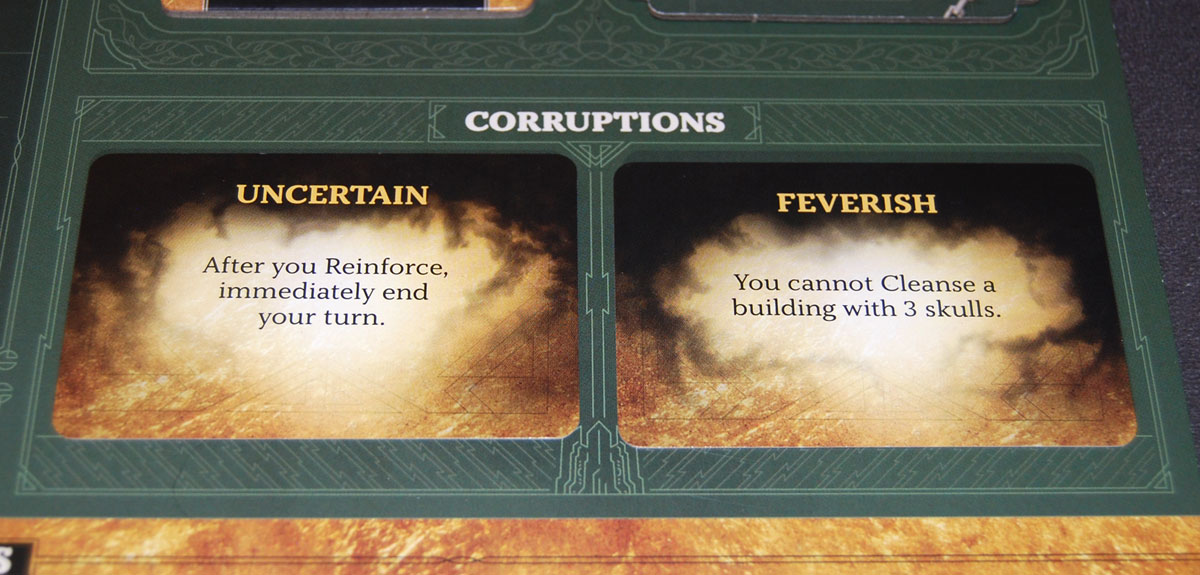
If you cannot pay the cost of a card, you gain a corruption card and place it on your board. Corruption cards have ongoing negative effects, and you can have up to two of them on your board. If you would ever gain a third corruption card, the players lose the game immediately.

The final option for your heroic action is to quest. The main goal is a bigger question that may take you some time to build up to, but you must complete the quest in order to draw the adversary out of the tower. Starting in the second month of the game, there will also be a companion quest and an adversary quest to complete. Each quest requires you to go to a certain location, and then either meet a particular requirement (spending resources, having a minimum number of something) or explore a dungeon. Dungeons are multi-room paths explored on the app—for each step you take, you will have to draw a dungeon card and apply its effects. Dungeon cards can also be improved with advantages. You can abandon a dungeon even without completing it, and any rooms you have explored will remain explored for the next player who attempts the dungeon.

If you complete a companion quest, you will gain the corresponding companion—these may give you advantages, as well as a special ability. In addition, each companion also has corresponding beneficial events that will occur periodically during the game.

The adversary quest will cause bad things to happen at the end of the month if it is not completed.
Finally, at one point during your turn, you may reinforce at a building in your space to get its benefit. Each building has a free effect, or an enhanced effect that you may use instead by spending spirit. Also, before reinforcing, you may choose to roll the haggle die. You might get an extra gear, warriors, potion, or you might lose your reinforce action altogether!
- Citadel: gain 1 potion, or spend 5 spirit to unlock one virtue.
- Sanctuary: gain 1 spirit, or spend 5 spirit to remove all of your corruptions.
- Village: gain 6 warriors, or spend 1 spirit to gain 12 warriors.
- Bazaar: gain 1 gear card, or spend 2 spirit to gain 1 treasure.
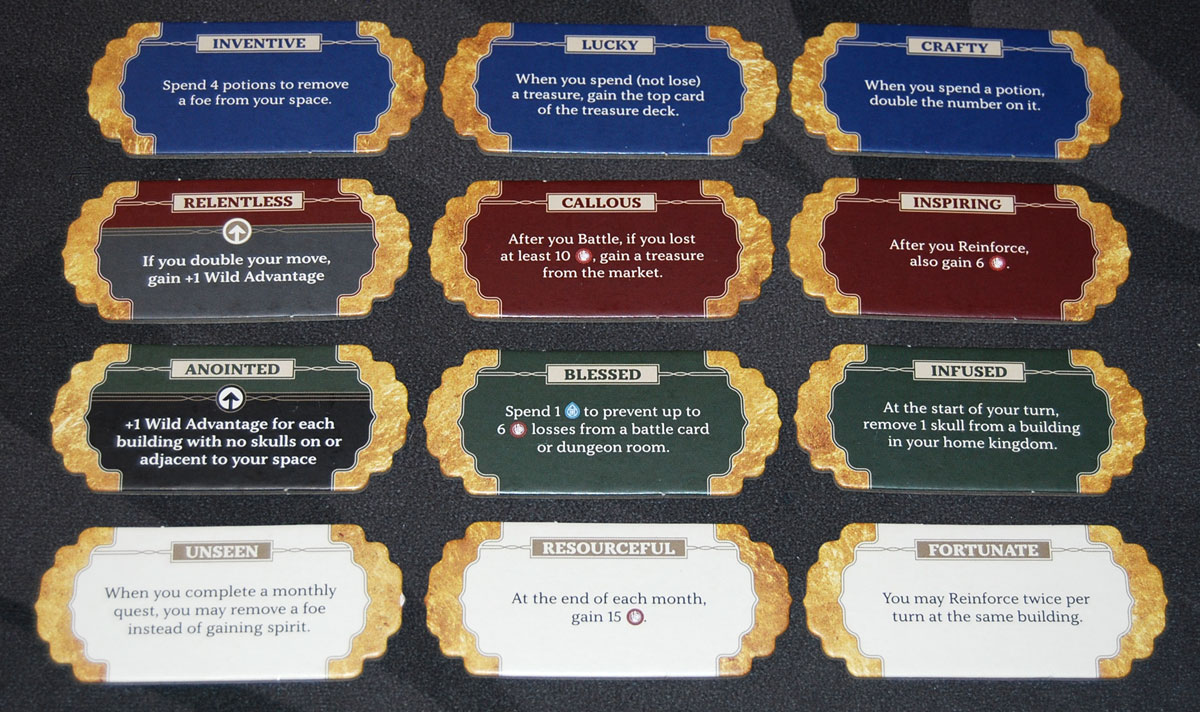
Your hero starts with three locked virtues—unlocking them gives you access to more powerful abilities, and may also give you some direction about what to focus on. The Relic Hunter is very good at acquiring and using potions and treasures. The Brutal Warlord is, as you may expect, good at fighting. The Orphaned Scion is good at clearing skulls from buildings, and the Spymaster moves quickly and is more effective at reinforcing.
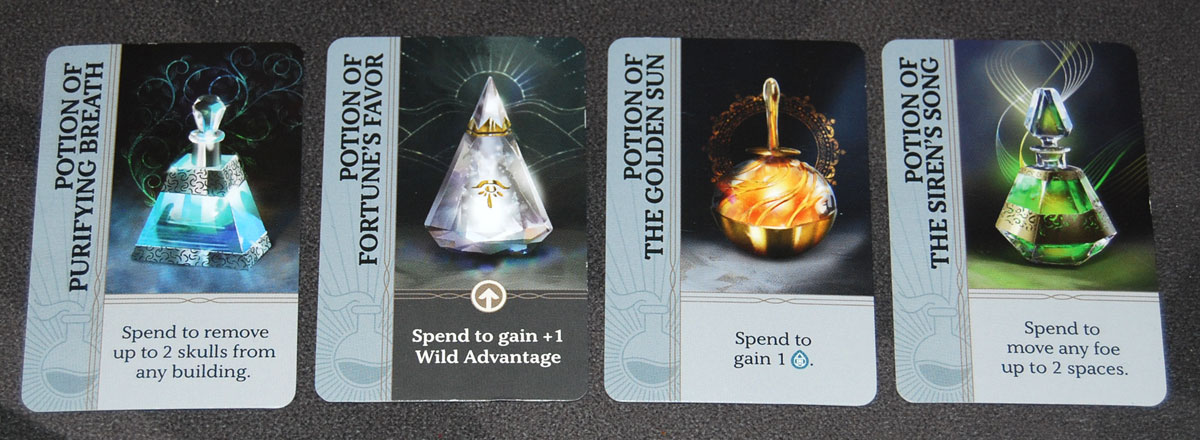
Potions have various effects and can be spent during your turn for a small boost.

Gear cards give you a permanent effect and aren’t spent when used (though there are some effects that may make you lose or spend gear). Some offer advantages, and some give you ongoing abilities. You may only have one of each gear card.
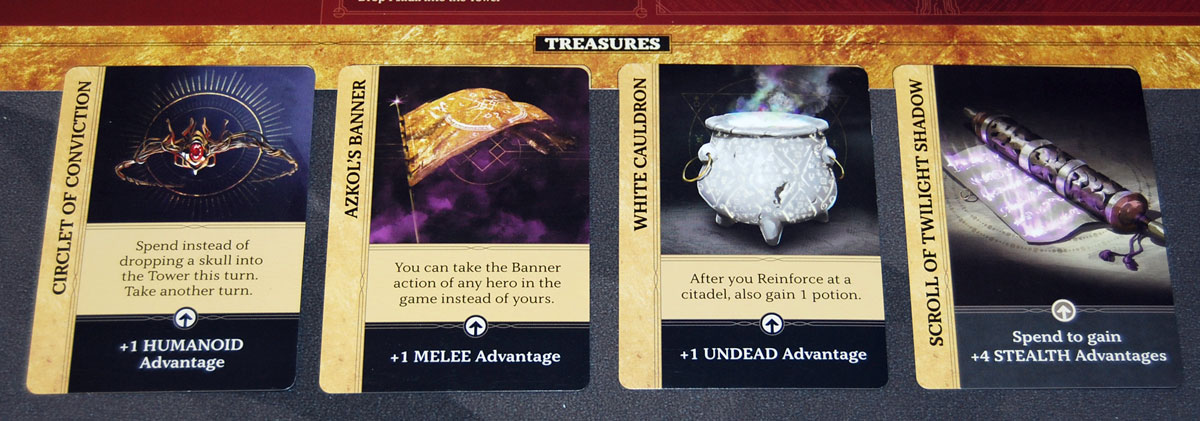
Treasure cards are a bit more powerful than gear: most of them offer an advantage of some sort and a benefit. Some treasures must be spent for their effects, and others offer an ongoing ability.
At the end of your turn, you must drop a skull into the top of the tower. The skull might come out one of the openings—if so, the player whose kingdom that side faces must place it into one of their buildings. If it came out in a kingdom that doesn’t belong to anyone, then the active player chooses a building in that kingdom to place it in.

If you ever add the fourth skull to a building, it is destroyed, and the player whose kingdom it is gains a corruption. The building and the skulls are all removed from the game. (If it was nobody’s home kingdom, the building is destroyed but nobody gets a corruption.)
Dropping a skull into the tower tells the app that your turn is over, and it also may trigger an event.

Enemies spawn or attack or grow in power; companions may help you; the tower might reveal a seal to be broken or rotate; the adversary may trigger its even from within the tower. Usually you will get a warning about the adversary, and then some number of turns later it will strike.

When the tower reveals a seal, it will light up facing one of the kingdoms, and the seal itself will glow and pulse. You slid the door up to remove it—if any skulls fall out, they are placed in that kingdom. Openings will allow more skulls to drop into that kingdom. The glyphs correspond to the various actions you can take on your turn: if a glyph is facing you, you must spend 1 spirit before taking that action.
The app itself will trigger the end of a month after a certain number of turns. In the first month, each player will take one turn and then the month ends. After that, there’s an average number of turns that will take place (based on the player count), but it’s not exact, so you’re never entirely certain when the month will end.
Game End
There are various situations that will cause you to lose the game:
- If a hero would gain a 3rd corruption.
- If you need to take a skull from the supply but there are none left.
- If the sixth month ends and you haven’t defeated the adversary.
There’s one way to win the game: complete the main goal, which brings the adversary onto the map, and then defeat the adversary.

Once you have brought the adversary out onto the board, it will no longer do its tower events, but instead has a different effect as it moves around on the map. When you fight the adversary, you have to draw 5 cards—however, unlike fighting the foes, you may retreat in the middle of a battle after resolving a card effect. Another significant difference is that if you spend advantages to improve an adversary’s battle card, it stays improved for future battles. Quite often, it may take multiple battles for players to attack the adversary, improve a few of the cards, and then retreat, and if you’re lucky you might draw some of the improved cards in the next battle and be able to survive 5 battle cards to win.
Return to Dark Tower is GeekDad Approved!
Why You Should Play Return to Dark Tower
I’ve never played the original Dark Tower, and so I don’t have any nostalgia for that game—unlike Fireball Island, it’s not one that I’d longed for as a kid. However, I’ve generally been enjoying the way that Restoration Games has been bringing these old, out-of-print games into the modern gaming era, and I had followed the original Kickstarter campaign with a lot of fascination about the game, the mix of physical components with the digital play, and (of course) the fancy gizmo that looms at the center.
Restoration Games provided a copy of the base game, so I did not have the neoprene game board or the extra miniatures for the enemies, but even without those the game looks great on the table and is really engaging.
One of the tricky things about app-driven games is the figuring out the balance of how much the app controls vs. how much the players control. Which cards should be physical decks and which cards should be digital, and why? Do you have the app keep track of a player’s inventory? Where they are on the board? In some app-driven games, the physical components can seem almost like an afterthought, just a nod to the idea of playing an analog game. It feels like you might as well be playing a digital-only game. In others, the game is primarily analog, and the app is little more than a fancy timer with some bells and whistles, or a player aid that could just as easily have been a book.
Return to Dark Tower strikes the right balance for me: the tower is a physical component that randomizes where the skulls fall out with a physical mechanism—it gives the players that illusion of control that you lose when an app spits out a random direction. You can see and hear the skull bouncing around inside the tower, whirring around when the internal mechanisms kick in, and spilling out when an opening lines up with a removed seal.
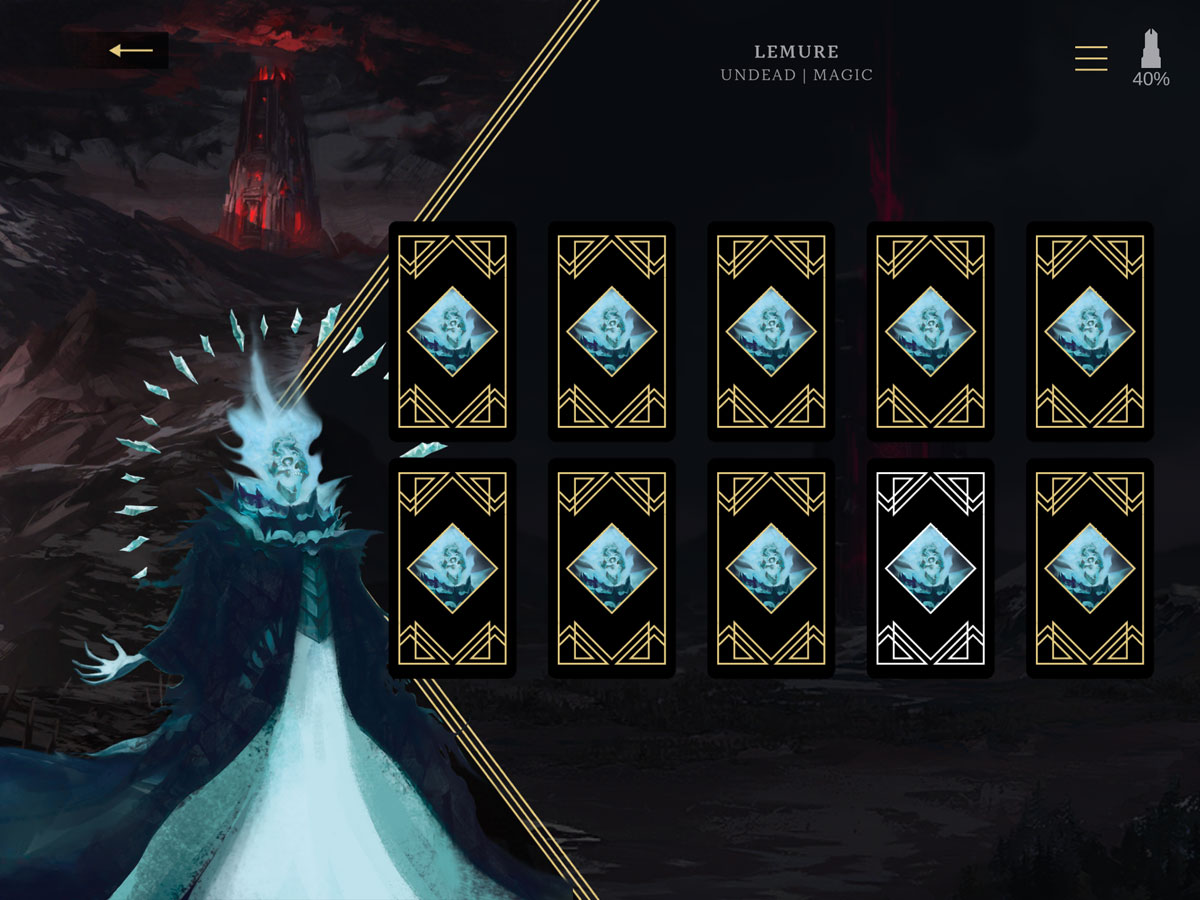
The app doesn’t really care what inventory you have, what treasures you’re carrying, or even where you are on the board. It’s more fun to have those physical items—you’re collecting gear, gaining and spending resources, shopping for the best treasure. When you enter a battle, the app doesn’t check if you actually have all the advantages you claim to have—it just trusts you to be honest. What the app controls, instead, is things like the monster cards—you draw 2 to 5 cards based on the enemy—and they’re randomized: you don’t have to worry about whether the 10 cards were shuffled well. But while this part of the game could be replaced by physical cards, it would be incredibly fiddly. Each of the foe’s cards has five different levels of effects, based on the foe’s current state and how many advantages you spend. You could, I suppose, just have a card that has all 5 effects on it, but part of what the app does is that it obscures some of the consequences. While you will learn with experience, you don’t know right away what the results of spending an advantage will be.
And for the adversary, this system wouldn’t work at all, because improved cards remain improved. Instead of 10 cards, you would actually need 50, and each time you improved a card you would need to find the matching cards in the supply to substitute. So that’s an area where the app enables a type of game design that would be tedious to replicate with physical components.
Another aspect that the app controls is the randomized events, and randomized month duration. You don’t know exactly when and where foes would spawn. I suppose this could also be replicated with a deck of cards or rolling dice and consulting a table, but with 60 different locations on the board, it would get unruly very quickly. I also like the suspense: every time a player drops a skull in the tower at the end of their turn, there’s a chance that there may be an event—will something happen this time? Will it be good or bad? You could do this to some extent with cards drawn from a deck, but the app also determines whether that card is drawn at all, and simplifies the process.
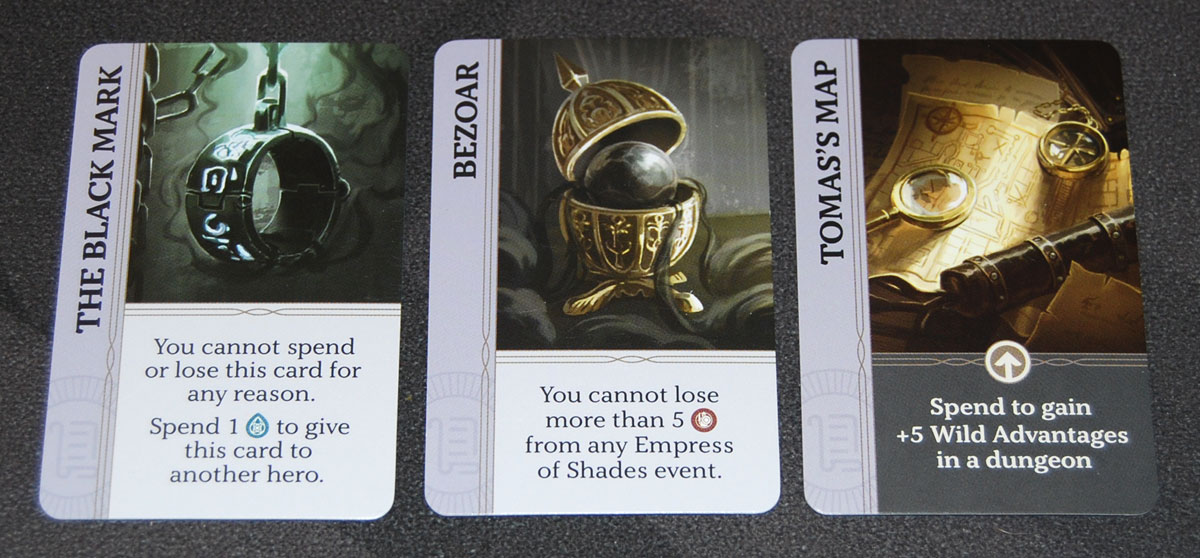
I’ve played (or taught the game at a local convention) enough times to see just about all of the different main goals and almost all of the adversaries, and I really love the way that the combination of just those two choices can give a very different feel to the game. In one, you’re trying to create an army of trees to surround the tower, which means you have to sacrifice a lot of your reinforce actions to direct the trees to move. In another, you need to travel to various dungeons to find the altars. One adversary sets the rivers on fire and you lose warriors if you cross them. Another one gives a Black Mark to one of the players, and whoever holds the mark is the target for the adversary’s attacks.
Similar to a game like Pandemic, there are the immediate fires that you need to put out, but you can’t lose sight of the long-term goals. In this case, though, there’s a little more of each. The skulls pile up on buildings and eventually destroy them, which causes corruption and prevents you from using that location for reinforcement, so it’s important to keep clearing those. Not to mention that you lose the game immediately if the supply runs out of skulls. But you’ve also got two missions each month: one that has no penalty for ignoring it but will award you with a valuable companion if you complete it, and another one that offers no reward for completion but will wreak havoc of some sort if you ignore it. Since the length of the month is uncertain, you have to guess whether you have time to do other things and get to the quests later.
All of this, though, is useless if you can’t defeat the adversary, and to do that, you have to complete the main goal. These are often quite costly, requiring massive amounts of spirit or warriors. It’s quite likely that you may have to pool resources, multiple players gathering what is needed and then meeting up to hand it off to the player who will complete the quest. The sooner you complete the quest, the sooner the adversary shows up on the board and stops triggering its horrible tower effects.
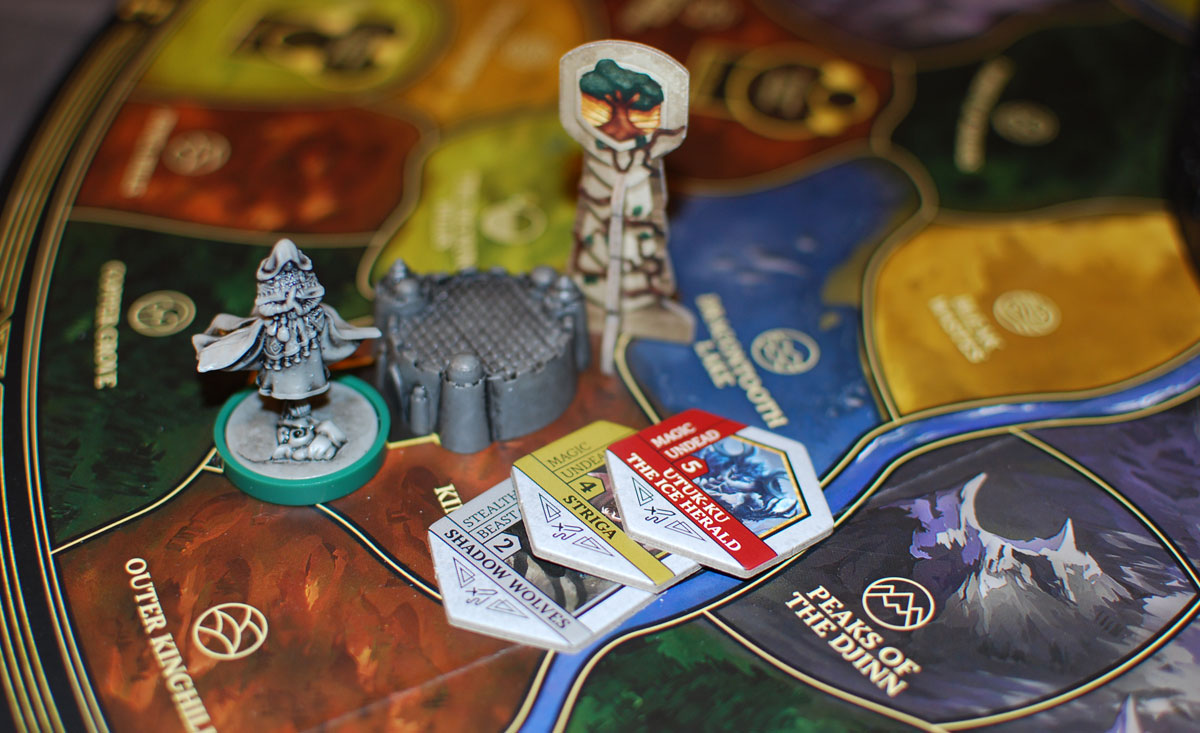
Before you breathe a sigh of relief, though, take note: the adversary won’t trigger tower effects, but it can still do a lot of damage while it’s roaming around the map. Each adversary has its own unique behavior, and part of the exploration of the game is learning what it can do and figuring out how best to counter it.
All in all, I’ve really enjoyed Return to Dark Tower, enough that I ended up buying myself the Alliances expansion when Restoration Games put some of the available inventory up for sale, and I’m considering whether to back for the new content that was included in the Backerkit campaign this fall. (Gotta decide by tomorrow!) It’s definitely an expensive game, and once you get it to the table, it’s really evident why. The tower is an engineering marvel, and the app itself is quite involved as well, not to mention all of the physical components.
If you prefer strictly analog games, I’m not sure the tower will win you over. I’ve had some friends who liked the gameplay but felt like the tower itself didn’t add to their experience, even though they liked what the app added. In that case, I think they may have preferred the app just tell them where the skulls landed or what glyphs each player had, instead of having a complex contraption that spun things around and physically revealed light-up symbols. But most of the people I’ve played with or taught it to have had a fun time with it, and I think if you get the opportunity to try it out, it’s certainly worth a spin. It’s one that I look forward to playing with my kids and my friends for a long time to come.
For more information about Return to Dark Tower, visit the Restoration Games website. To place a late pledge (by October 31!), visit the Backerkit Page.
Click here to see all our tabletop game reviews.
![]() To subscribe to GeekDad’s tabletop gaming coverage, please copy this link and add it to your RSS reader.
To subscribe to GeekDad’s tabletop gaming coverage, please copy this link and add it to your RSS reader.
Disclosure: GeekDad received a copy of this game for review purposes.
Click through to read all of "Reaping the Rewards: ‘Return to Dark Tower’" at GeekDad.If you value content from GeekDad, please support us via Patreon or use this link to shop at Amazon. Thanks!


